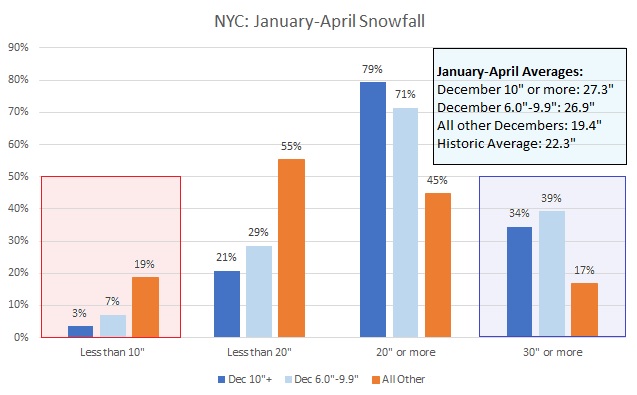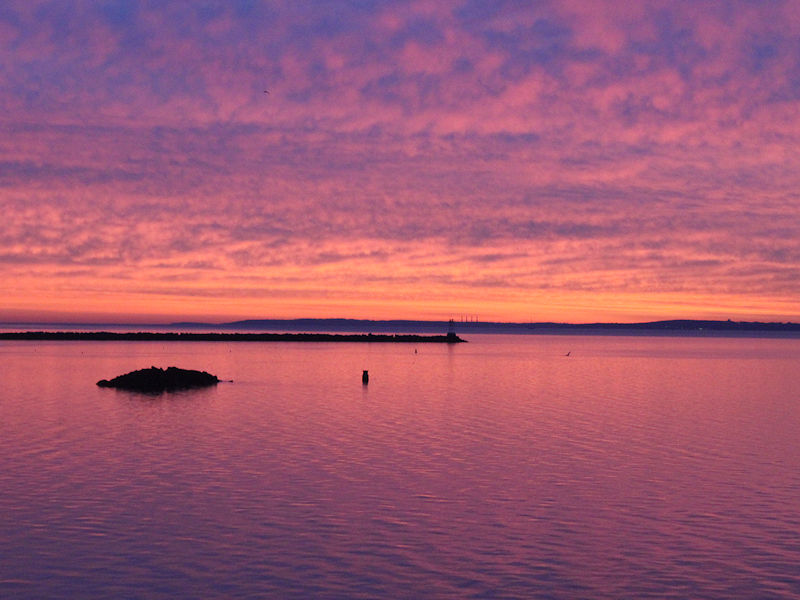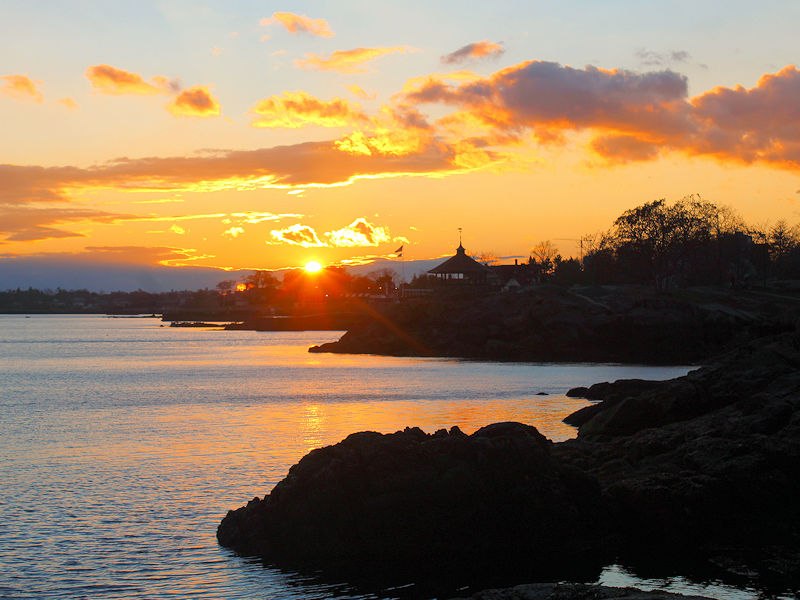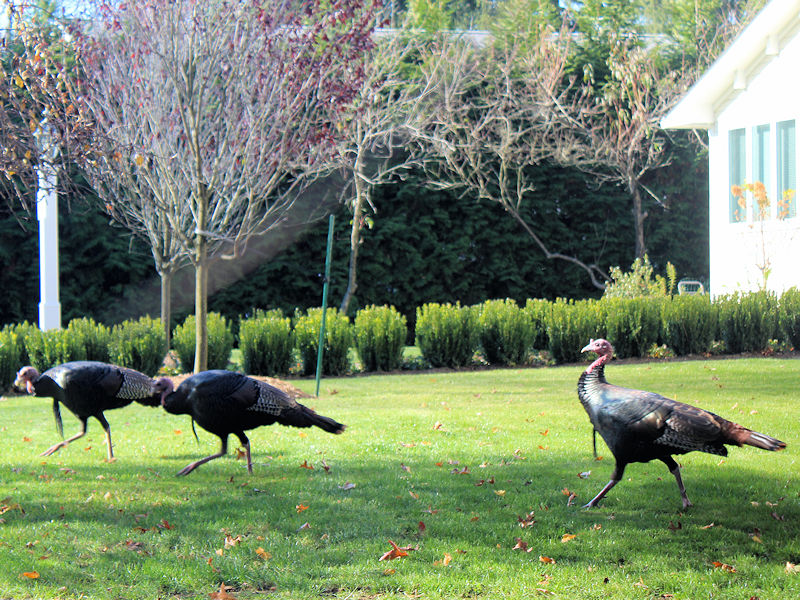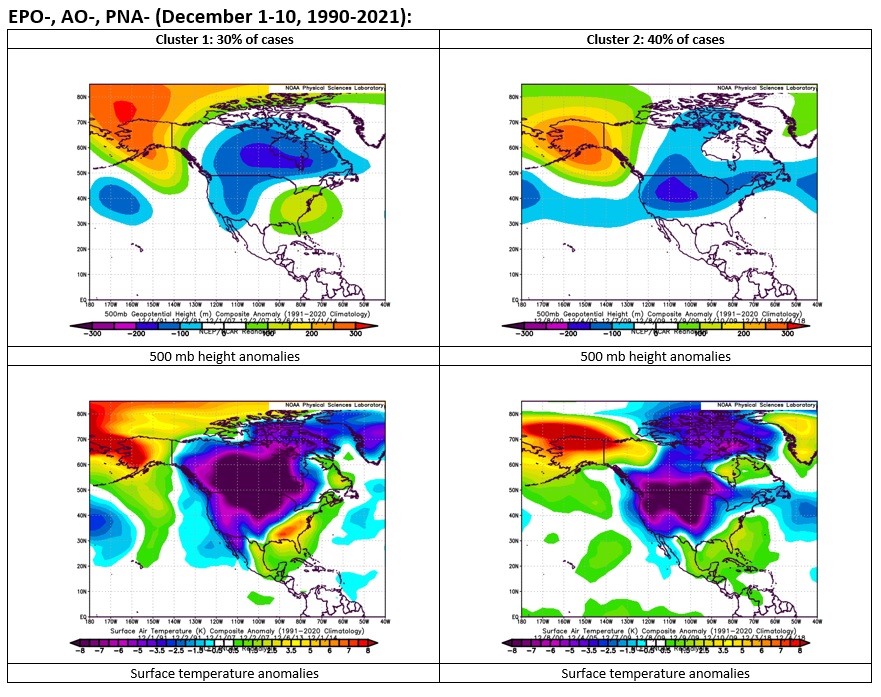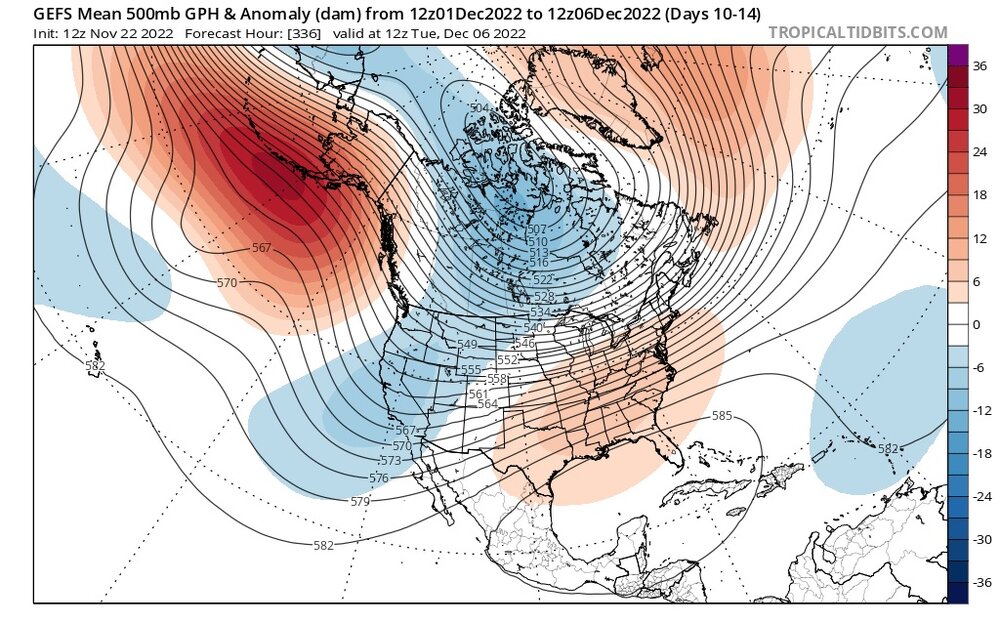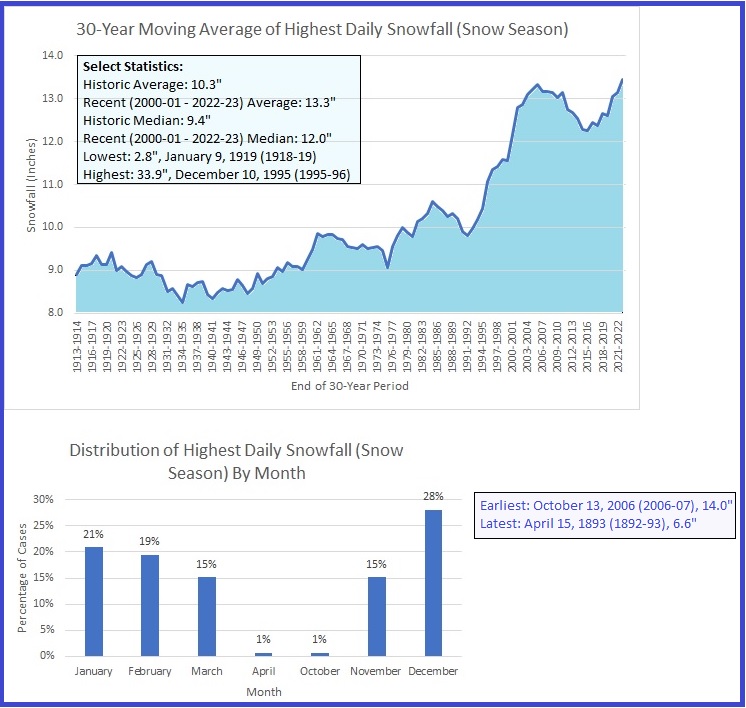-
Posts
22,982 -
Joined
Content Type
Profiles
Blogs
Forums
American Weather
Media Demo
Store
Gallery
Everything posted by donsutherland1
-
Morning thoughts… Today will be partly sunny and cool. High temperatures will reach the middle and upper 40s in most of the region. Likely high temperatures around the region include: New York City (Central Park): 45° Newark: 48° Philadelphia: 49° Temperatures will rebound tomorrow, but rain is likely. Normals: New York City: 30-Year: 49.4°; 15-Year: 49.7° Newark: 30-Year: 50.0°; 15-Year: 50.4° Philadelphia: 30-Year: 51.0°; 15-Year: 51.5°
-
I'm increasingly optimistic about the forecast blocking and snowfall potential. Keep in mind that there are some adverse risks. Consider December 1958 and winter 1958-59 as an example. But those have been the exception, not the rule.
-
Tomorrow will be cool day. However, temperatures will rebound during the middle of the week. New York City will very likely see a November mean temperature of 50° or above for the 21st time and second time in the last three years. A disproportionate share of 50° or warmer November cases has occurred since 2000. Records go back to 1869. December could start mild. However, with the development of an EPO-/AO-/PNA- pattern, colder air intrusions could become more frequent after the first week of December, should the teleconnection forecast verify and the most common clusters of 500 mb patterns (75% of such cases) develop. The latest EPS suggests that the AO could fall to -3.000 or below during the second week of December. Since 1950, there were 24 cases that saw the AO reach -3.000 or below during December. Mean snowfall for those cases was 6.2" (Median: 6.0"). 50% of such cases saw December wind up with 6.0" or more snow (25% saw 10.0" or more). In contrast, during all other December cases, mean December snowfall was 3.5" (Median: 2.5"). In those cases, 21% of years saw December snowfall of 6.0" or more while 8% saw 10.0" or more snowfall. The ENSO Region 1+2 anomaly was -1.7°C and the Region 3.4 anomaly was -0.8°C for the week centered around November 23. For the past six weeks, the ENSO Region 1+2 anomaly has averaged -1.57°C and the ENSO Region 3.4 anomaly has averaged -0.92°C. La Niña conditions will likely persist through mid-winter. The SOI was +23.28 today. The preliminary Arctic Oscillation (AO) was -1.425 today. On November 26 the MJO was in Phase 7 at an amplitude of 1.826 (RMM). The November 25-adjusted amplitude was 1.631 (RMM). Based on sensitivity analysis applied to the latest guidance, there is an implied near 100% probability that New York City will have a warmer than normal November (1991-2020 normal). November will likely finish with a mean temperature near 50.9° (2.9° above normal).
-
-
Morning thoughts… Today will be partly sunny and breezy. Temperatures will likely fall during the afternoon. High temperatures will reach the lower and middle 50s in most of the region. Likely high temperatures around the region include: New York City (Central Park): 53° Newark: 55° Philadelphia: 54° It will turn cooler for tomorrow and Tuesday before temperatures rebound. Normals: New York City: 30-Year: 49.7°; 15-Year: 50.0° Newark: 30-Year: 50.3°; 15-Year: 50.7° Philadelphia: 30-Year: 51.3°; 15-Year: 51.8°
-
Yes. Those with 10" or more do even better.
-
A few additional showers are likely through midnight. Temperatures will remain will be unseasonably mild overnight. Cooler air will overspread the region tomorrow, but temperatures could rebound during the middle of the week. New York City will very likely see a November mean temperature of 50° or above for the 21st time and second time in the last three years. A disproportionate share of 50° or warmer November cases has occurred since 2000. Records go back to 1869. December could start mild. However, with the development of an EPO-/AO-/PNA- pattern, colder air intrusions could become more frequent after the first week of December, should the teleconnection forecast verify and the most common clusters of 500 mb patterns (75% of such cases) develop. The latest EPS suggests that the AO could fall to -3.000 or below during the second week of December. Since 1950, there were 24 cases that saw the AO reach -3.000 or below during December. Mean snowfall for those cases was 6.2" (Median: 6.0"). 50% of such cases saw December wind up with 6.0" or more snow (25% saw 10.0" or more). In contrast, during all other December cases, mean December snowfall ws 3.5" (Median: 2.5"). In those cases, 21% of years saw December snowfall of 6.0" or more while 8% saw 10.0" or more snowfall. The ENSO Region 1+2 anomaly was -1.3°C and the Region 3.4 anomaly was -0.8°C for the week centered around November 16. For the past six weeks, the ENSO Region 1+2 anomaly has averaged -1.62°C and the ENSO Region 3.4 anomaly has averaged -0.92°C. La Niña conditions will likely persist into the winter. The SOI was +10.02 today. The preliminary Arctic Oscillation (AO) was -0.533 today. On November 25 the MJO was in Phase 7 at an amplitude of 1.630 (RMM). The November 24-adjusted amplitude was 1.318 (RMM). Based on sensitivity analysis applied to the latest guidance, there is an implied near 100% probability that New York City will have a warmer than normal November (1991-2020 normal). November will likely finish with a mean temperature near 50.8° (2.8° above normal).
-
Morning thoughts… Rain will arrive late this morning or early this afternoon. It will be another mild day. High temperatures will reach the middle and upper 50s in most of the region. Likely high temperatures around the region include: New York City (Central Park): 57° Newark: 59° Philadelphia: 60° It will turn cooler for tomorrow and Tuesday before temperatures rebound. Normals: New York City: 30-Year: 50.0°; 15-Year: 50.3° Newark: 30-Year: 50.7°; 15-Year: 51.1° Philadelphia: 30-Year: 51.7°; 15-Year: 52.1°
-
-
Under bright sunshine, the temperature again rose into the middle and upper 50s across the region. Newark reached 60°. Down South, Miami reached 87° for the 11th time this month. That tied the November record, which was set in 1986 and tied in 2015. Rain will return to the region tomorrow into Monday. Most of the region will see 0.25"-0.75" of rain. There could be some locally higher amounts. Temperatures will remain generally mild. Overall, temperatures will generally be near to above normal through the remainder of November. New York City will very likely see a November mean temperature of 50° or above for the 21st time and second time in the last three years. A disproportionate share of 50° or warmer November cases has occurred since 2000. Records go back to 1869. December could start mild. However, with the development of an EPO-/AO-/PNA- pattern, colder air intrusions could become more frequent after the first week of December, should the teleconnection forecast verify and the most common clusters of 500 mb patterns (75% of such cases) develop. The ENSO Region 1+2 anomaly was -1.3°C and the Region 3.4 anomaly was -0.8°C for the week centered around November 16. For the past six weeks, the ENSO Region 1+2 anomaly has averaged -1.62°C and the ENSO Region 3.4 anomaly has averaged -0.92°C. La Niña conditions will likely persist into the winter. The SOI was -4.27 today. The preliminary Arctic Oscillation (AO) was -0.241 today. On November 24 the MJO was in Phase 7 at an amplitude of 1.316 (RMM). The November 23-adjusted amplitude was 1.246 (RMM). Based on sensitivity analysis applied to the latest guidance, there is an implied near 100% probability that New York City will have a warmer than normal November (1991-2020 normal). November will likely finish with a mean temperature near 50.8° (2.8° above normal).
-
After a sunny start to the weekend, rain will return to the region Sunday into Monday. Temperatures will remain generally mild. Overall, temperatures will generally be near to above normal through the remainder of November. New York City will very likely see a November mean temperature of 50° or above for the 21st time and second time in the last three years. A disproportionate share of 50° or warmer November cases has occurred since 2000. Records go back to 1869. December could start mild. However, with the development of an EPO-/AO-/PNA- pattern, colder air intrusions could become more frequent after the first week of December, should the teleconnection forecast verify and the most common clusters of 500 mb patterns (75% of such cases) develop. The ENSO Region 1+2 anomaly was -1.3°C and the Region 3.4 anomaly was -0.8°C for the week centered around November 16. For the past six weeks, the ENSO Region 1+2 anomaly has averaged -1.62°C and the ENSO Region 3.4 anomaly has averaged -0.92°C. La Niña conditions will likely persist into the winter. The SOI was +1.97 today. The preliminary Arctic Oscillation (AO) was -0.738 today. On November 23 the MJO was in Phase 6 at an amplitude of 1.243 (RMM). The November 22-adjusted amplitude was 1.252 (RMM). Based on sensitivity analysis applied to the latest guidance, there is an implied near 100% probability that New York City will have a warmer than normal November (1991-2020 normal). November will likely finish with a mean temperature near 50.6° (2.6° above normal).
-
-
Morning thoughts… Clouds and showers will give way to partly sunny skies this afternoon. High temperatures will reach the lower and middle 50s in most of the region. Likely high temperatures around the region include: New York City (Central Park): 52° Newark: 55° Philadelphia: 56° The remainder of November will be generally milder than normal. Normals: New York City: 30-Year: 50.7°; 15-Year: 50.9° Newark: 30-Year: 51.4°; 15-Year: 51.8° Philadelphia: 30-Year: 52.4°; 15-Year: 52.7°
-
Tomorrow will be variably cloudy and mild. There could be a few showers. The weekend could see additional rainfall, along with continued mild readings. Overall, temperatures will generally be near to above normal through the remainder of November. New York City will very likely see a November mean temperature of 50° or above for the 21st time and second time in the last three years. A disproportionate share of 50° or warmer November cases has occurred since 2000. Records go back to 1869. December could start mild. However, with the development of an EPO-/AO-/PNA- pattern, colder air intrusions could become more frequent after the first week of December, should the teleconnection forecast verify and the most common clusters of 500 mb patterns (75% of such cases) develop. The ENSO Region 1+2 anomaly was -1.3°C and the Region 3.4 anomaly was -0.8°C for the week centered around November 16. For the past six weeks, the ENSO Region 1+2 anomaly has averaged -1.62°C and the ENSO Region 3.4 anomaly has averaged -0.92°C. La Niña conditions will likely persist into the winter. The SOI was +11.39 today. The preliminary Arctic Oscillation (AO) was -0.598 today. On November 22 the MJO was in Phase 6 at an amplitude of 1.248 (RMM). The November 21-adjusted amplitude was 1.165 (RMM). Based on sensitivity analysis applied to the latest guidance, there is an implied 99% probability that New York City will have a warmer than normal November (1991-2020 normal). November will likely finish with a mean temperature near 50.4° (2.4° above normal).
-
-
Morning thoughts… Today will be partly sunny and mild. High temperatures will reach the lower and middle 50s in most of the region. Likely high temperatures around the region include: New York City (Central Park): 53° Newark: 56° Philadelphia: 58° The remainder of November will be generally milder than normal. Normals: New York City: 30-Year: 51.1°; 15-Year: 51.3° Newark: 30-Year: 51.8°; 15-Year: 52.1° Philadelphia: 30-Year: 52.8°; 15-Year: 53.1°
-
Under abundant sunshine, the mercury soared into the middle and even upper 50s today. Tomorrow will be slightly cooler, but still mild. The weekend could see some rainfall, along with continued mild readings. Overall, temperatures will generally be near to above normal through the remainder of November. The ENSO Region 1+2 anomaly was -1.3°C and the Region 3.4 anomaly was -0.8°C for the week centered around November 16. For the past six weeks, the ENSO Region 1+2 anomaly has averaged -1.62°C and the ENSO Region 3.4 anomaly has averaged -0.92°C. La Niña conditions will likely persist into the winter. The SOI was +4.83 today. The preliminary Arctic Oscillation (AO) was -0.117 today. On November 21 the MJO was in Phase 6 at an amplitude of 1.162 (RMM). The November 20-adjusted amplitude was 1.107 (RMM). Based on sensitivity analysis applied to the latest guidance, there is an implied 97% probability that New York City will have a warmer than normal November (1991-2020 normal). November will likely finish with a mean temperature near 50.1° (2.1° above normal).
-
Morning thoughts… Today will be mostly sunny and mild. High temperatures will reach the lower and middle 50s in most of the region. Likely high temperatures around the region include: New York City (Central Park): 54° Newark: 57° Philadelphia: 57° The remainder of November will be generally milder than normal. Normals: New York City: 30-Year: 51.4°; 15-Year: 51.6° Newark: 30-Year: 52.1°; 15-Year: 52.4° Philadelphia: 30-Year: 53.1°; 15-Year: 53.4°
-
The latest teleconnections forecast suggests that the first 10 days of December could see an EPO-/AO-/PNA- pattern. During the December 1-10, 1990-2021 period, there were two major clusters of 500 mb outcomes that accounted for 70% of all such cases. The November 22, 2022 12z run of the GEFS suggests an outcome similar to Cluster 1 during the Day 10-14 period with the cold anomalies somewhat farther to the west than shown on the composite. What's noteworthy is that in both of the most common clusters of outcomes, there was expansive cold in Canada and parts of North America. Should such cold be present, there could be some potential for snowfall during the first half of December as the cold possibly tries to press eastward. All of the cases in Cluster 1 saw one or more snowfalls during the first half of December. In sum, there's some potential for wintry weather in the extended range. Of course, the forecast state of the teleconnections is subject to uncertainty at such extended timeframes.
-
Milder air moved back into the region today. High temperatures rose into the lower 50s in many areas including: Atlantic City: 55° Islip: 51° New York City: 51° Newark: 53° Philadelphia: 54° Tomorrow will see temperatures again top out in the 50s. The weekend could see some rainfall, along with continued mild readings. Overall, temperatures will generally be near to above normal through the remainder of November. The ENSO Region 1+2 anomaly was -1.3°C and the Region 3.4 anomaly was -0.8°C for the week centered around November 16. For the past six weeks, the ENSO Region 1+2 anomaly has averaged -1.62°C and the ENSO Region 3.4 anomaly has averaged -0.92°C. La Niña conditions will likely persist into the winter. The SOI was -6.62 today. The preliminary Arctic Oscillation (AO) was +0.154 today. On November 20 the MJO was in Phase 5 at an amplitude of 1.105 (RMM). The November 19-adjusted amplitude was 0.995 (RMM). Based on sensitivity analysis applied to the latest guidance, there is an implied 91% probability that New York City will have a warmer than normal November (1991-2020 normal). November will likely finish with a mean temperature near 49.9° (1.9° above normal).
-

Upstate/Eastern New York-Into Winter!
donsutherland1 replied to BuffaloWeather's topic in Upstate New York/Pennsylvania
Thanks for this information. -

Upstate/Eastern New York-Into Winter!
donsutherland1 replied to BuffaloWeather's topic in Upstate New York/Pennsylvania
On November 19, 2022, Buffalo picked up 21.5" daily snowfall during a 4-day lake effect snowstorm that deposited 36.6" of snow. The average highest daily snowfall during the snow season has been increasing in recent years. -
Yes. Most days will have highs of 50 or above for the remainder of November.
-
Morning thoughts… Today will be mostly sunny and noticeably milder. High temperatures will reach the upper 40s and lower 50s in most of the region. Likely high temperatures around the region include: New York City (Central Park): 50° Newark: 52° Philadelphia: 53° The remainder of November will be generally warmer than normal. Normals: New York City: 30-Year: 51.8°; 15-Year: 51.9° Newark: 30-Year: 52.5°; 15-Year: 52.8° Philadelphia: 30-Year: 53.5°; 15-Year: 53.7°
-

Historic Lake Effect Event?! 11/17-11/21
donsutherland1 replied to BuffaloWeather's topic in Upstate New York/Pennsylvania
Many thanks. I will look forward to adding them.




